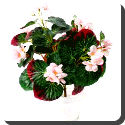 Begonia — Begonia is a genus in the flowering plant family Begoniaceae. The only other member of the family Begoniaceae is Hillebrandia, a genus with a single species in the Hawaiian Islands. The genus Symbegonia is now included in Begonia. “Begonia” is the common name as well as the generic name for all members of the genus.
Begonia — Begonia is a genus in the flowering plant family Begoniaceae. The only other member of the family Begoniaceae is Hillebrandia, a genus with a single species in the Hawaiian Islands. The genus Symbegonia is now included in Begonia. “Begonia” is the common name as well as the generic name for all members of the genus.
With ca. 1500+ species, Begonia is one of the ten largest angiosperm genera. The species are terrestrial (sometimes epiphytic) herbs or undershrubs and occur in subtropical and tropical moist climates, in South and Central America, Africa and southern Asia. Terrestrial species in the wild are commonly upright-stemmed, rhizomatous, or tuberous. The plants are monoecious, with unisexual male and female flowers occurring separately on the same plant, the male containing numerous stamens, the female having a large inferior ovary and two to four branched or twisted stigmas. In most species the fruit is a winged capsule containing numerous minute seeds, although baccate fruits are also known. The leaves, which are often large and variously marked or variegated, are usually asymmetric (unequal-sided).
Because of their sometimes showy flowers of white, pink, scarlet or yellow color and often attractively marked leaves, many species and innumerable hybrids and cultivars are cultivated. The genus is unusual in that species throughout the genus, even those coming from different continents, can frequently be hybridized with each other, and this has led to an enormous number of cultivars. The American Begonia Society classifies begonias into several major groups: cane-like, shrub-like, tuberous, rhizomatous, semperflorens, rex, trailing-scandent, or thick-stemmed. For the most part these groups do not correspond to any formal taxonomic groupings or phylogeny and many species and hybrids have characteristics of more than one group, or fit well into none of them.
The different groups of begonias have different cultural requirements but most species come from tropical regions and therefore they and their hybrids require warm temperatures. Most are forest understory plants and require bright shade; few will tolerate full sun, especially in warmer climates. In general, begonias require a well-drained growing medium that is neither constantly wet nor allowed to dry out completely. Many begonias will grow and flower year-round but tuberous begonias usually have a dormant period, during which the tubers can be stored in a cool and dry place.
 Kids Portal For Parents India Kids Network
Kids Portal For Parents India Kids Network






